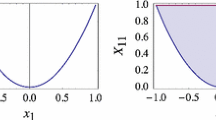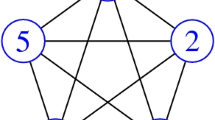Abstract
The problem of minimizing a (non-convex) quadratic function over the simplex (the standard quadratic optimization problem) has an exact convex reformulation as a copositive programming problem. In this paper we show how to approximate the optimal solution by approximating the cone of copositive matrices via systems of linear inequalities, and, more refined, linear matrix inequalities (LMI's). In particular, we show that our approach leads to a polynomial-time approximation scheme for the standard quadratic optimzation problem. This is an improvement on the previous complexity result by Nesterov who showed that a 2/3-approximation is always possible. Numerical examples from various applications are provided to illustrate our approach.
Similar content being viewed by others
References
Bellare, M. and Rogaway, P. (1995), The Complexity of Approximating a Nonlinear Program, Mathematical Programming 69, 429–441.
Berkelaar, A.B., Jansen, B., Roos, C. and Terlaky, T. (1996), Sensitivity Analysis in (Degenerate) Quadratic Programming. Technical Report TWI 96–26, Reports of the Faculty of Technical Mathematics and Informatics, Delft University of Technology.
Bomze, I.M. (1998), On Standard Quadratic Optimization Problems, Journal of Global Optimization 13, 369–387.
Bomze, I.M., Dür, M., de Klerk, E., Roos, C., Quist, A. and Terlaky, T. (2000), On Copositive Programming and Standard Quadratic Optimization Problems, Journal of Global Optimization 18, 301–320.
de Klerk, E. and Pasechnik, D.V. (2002), Approximation of the Stability Number of a Graph via Copositive Programming, SIAM Journal of Optimization 12(4), 875–892.
Goemans, M.X. and Williamson, D.P. (1995), Improved approximation algorithms for maximum cut and satisfiability problems using semidefinite programming, Journal of the ACM 42, 1115–1145.
Hastad, J. (1999), Clique is Hard to Approximate Within uV u, Acta Mathematica 182, 105–142.
Motzkin, T.S. and Straus, E.G. (1965), Maxima for Graphs and a New Proof of a Theorem of Túran, Canadian J. Math. 17, 533–540.
Murty, K.G. and Kabadi, S.N. (1987), Some NP-Complete Problems in Quadratic and Linear Programming, Mathematical Programming 39, 117–129.
Nesterov, Y.E. (1999), Global Quadratic Optimization on the Sets with Simplex Structure. Discussion paper 9915, CORE, Katholic University of Louvain, Belgium.
Nesterov, Y.E. and Nemirovskii, A.S. (1994), Interior Point Methods in Convex Programming: Theory and Applications. SIAM, Philadelphia, PA.
Nesterov, Y.E., Wolkowicz, H. and Ye, Y. (2000), Nonconvex Quadratic Optimization, in Wolkowicz, H., Saigal, R. and Vandenberghe, L. (eds.), Handbook of Semidefinite Programming, pp. 361–416. Kluwer Academic Publishers, Dordrecht.
Papadimitriou, C.H. and Steiglitz, K. (1982), Combinatorial Optimization. Algorithms and Complexity. Prentice Hall, Inc., Englewood Cliffs, N.J.
Parrilo, P.A. (2000), Structured Semidefinite Programs and Semi-algebraic Geometry Methods in Robustness and Optimization. PhD thesis, California Institute of Technology, Pasadena, California, USA. Available at: http://www.cds.caltech.edu/pablo/.
Parrilo, P.A. and Sturmfels, B. (2001), Minimizing polynomial functions, Tech. Rep. math. OC/0103170, DIMACS, Rutgers University, March.
Pólya, G. (1928), Uber positive Darstellung von Polynomen. Vierteljschr. Naturforsch. Ges. ¨ Zurich, 73, 141–145 (also Collected Papers 2, 309–313, MIT Press, Cambridge, MA, London, 1974).
Powers, V. and Reznick, B. (2001), A New Bound for Pólya's Theorem with Applications to Polynomials Positive on Polyhedra, J. Pure Appl. Alg. 164, 221–229.
J. Renegar (2001), A Mathematical View of Interior-Point Methods in Convex Optimization. Forthcoming, SIAM, Philadelphia, PA.
Quist, A.J., de Klerk, E., Roos, C. and Terlaky, T. (1998), Copositive Relaxation for General Quadratic Programming, Optimization Methods and Software 9, 185–209.
Sturm, J.F. (1999), Using SeDuMi 1.02, a MATLAB Toolbox for Optimization Over Symmetric Cones, Optimization Methods and Software 11–12, 625–653.
Vickers, G.T. and Cannings, C. (1988), Patterns of ESS's I, J. Theor. Biol. 132, 387–408.
Author information
Authors and Affiliations
Rights and permissions
About this article
Cite this article
Bomze, I.M., De Klerk, E. Solving Standard Quadratic Optimization Problems via Linear, Semidefinite and Copositive Programming. Journal of Global Optimization 24, 163–185 (2002). https://doi.org/10.1023/A:1020209017701
Issue Date:
DOI: https://doi.org/10.1023/A:1020209017701




